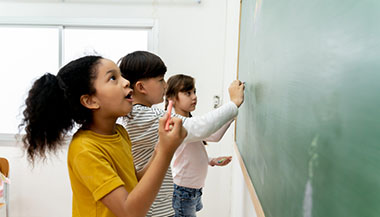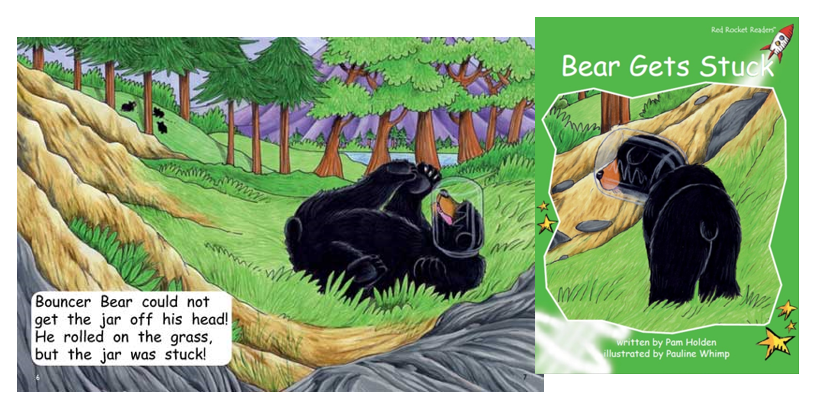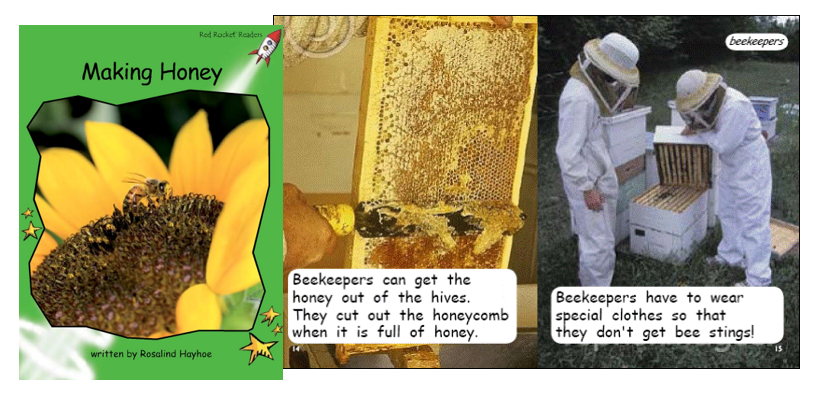A Disappearing Practice that Deserves the Spotlight
When I enter Ms. Williams’s first-grade classroom during her writing workshop time, several children race to greet me, wanting to show me their latest works. I sidle up next to one student who shares with me what he has written, “I went to the zoo with my mom.” The line of text is accompanied with a lovely illustration of him, his mom, and a monkey hanging on a branch.
I approach a few other children to see what they are up to, and it amazes me how there are several of them filling out a whole page, desperate to tell their stories. Ms. Williams tells me later that this is the first year she has had a group of children who immediately begin writing during writing workshop without spending half their writing time figuring out what to write. She says, “It’s like they’re writing in a diary!” Ms. Williams attributes this phenomenon to a regular practice that she and I have been engaging in with the children – interactive writing.
The origins of interactive writing can be traced back to Ashton-Warner’s (1963) description of the Language Experience Approach (LEA), where the child dictates what to write and the teacher writes it down word-for-word. McKenzie (1985) built on this approach by developing Shared Writing, a similar technique to LEA with the exception that the teacher may take liberties with the children’s wording of a text. Sadly, interactive writing has all but disappeared from classrooms even though prominent researchers say that it is a topic that “should be hot” (Grote-Garcia & Ortlieb, 2023).
In interactive writing, the teacher and students share the pen, creating a process where the children are more active. Over the course of time, the teacher gradually releases control, while the children gain control over the task (Button, 1996). It is an easily implemented strategy (Patterson, 2008), but it does take practice on the part of both the teacher and children.
Materials for interactive writing are minimal. Henry (1999) suggests having an “area that is engineered for interactive writing” (p.11 ), complete with an easel, markers, chart paper, magnetic letters, reference charts, and white-out tape.
As the teacher and children share the writing task, it is important that the children take ownership of the writing. This is accomplished because the teacher lets go of some of the control and allows the children to write what they are able to at their current level of learning, only stepping in if they judge the task is too difficult (Hall, 2000).
An important aspect of interactive writing is to write for the authentic purpose of communicating to an audience (Hall, 2000). Writing topics are generated by meaningful conversations between the children and the teacher. The topic may be related to a shared classroom experience (Clay, 2005) or books that the class has shared (Clay, 2005; Hall, 2000). Together, the children and teacher determine what they will say about the topic. A natural conversation supports the oral composition of the text (McCarrier, 2018), although the teacher can ask questions to help elaborate on the students’ ideas.
Writing in response to reading has been shown to have positive effects on reading success (Graham & Herbert, 2011), so interactive writing should be a priority in the classroom schedule. Interactive writing is also useful to demonstrate for young children how to respond to reading. Here are two ways teachers can use interactive writing to teach children to respond to texts.
Bear Gets Stuck (Level G)
In this story, Bouncer Bear has quite an adventure when he gets his head stuck in a jar while looking for food in a garbage pile. The park rangers rescue him, of course!
A favorite reading response activity is having the children devise an alternative ending of a story or a sequel. For example, the teacher might ask the children, “What will happen to Bouncer Bear the next time he ventures out to look for food?”
Making Honey (Level I)
This beautiful book tells the reader all about how bees make honey. It includes close-up photos of bees at work.
After reading this text, the teacher and children can create a flow map of the honey-making process that includes their own illustrations. Then, using interactive writing, the class can caption and label one or two illustrations per day.
My hope is that in the very near future, when I visit kindergarten and first-grade classrooms, especially, I will see authentic writing posted on the walls in and outside of the classroom – writing resulting from the shared effort of children and their teacher. Writing that is written for a real audience, meant to be read by others, and carries the voices of the children who wrote it alongside their teacher.
Happy Reading!
References
Ashton-Warner, S. (1963). Teacher. Touchstone Books.
Button, K., Johnson, M. J., & Furgerson, P. (1996). Interactive writing in a primary classroom. The Reading Teacher, 49(6), 446-454.
Clay, M. M. (2005). Literacy lessons: Designed for individuals, Part Two. Heinemann.
Graham, S., & Herbert, M. (2011). Writing to read: A meta-analysis of the impact of writing and writing instruction on reading. Harvard Educational Review, 81, 710-745.
Grote-Garcia, S., & Ortlieb, E. (2023). What’s hot in literacy 2023: The ban on books and diversity measures. Literacy Research and Instruction, 63(1), 1-16.
Hall, N. (2000). Interactive writing with young children. Childhood Education, 76(6), 358-364.
Henry, J., & Wiley, J. (1999). Answers to frequently asked questions about interactive writing. Connections, 11-13.
McCarrier, A., Fountas, I. C., & Pinnell, G. S. (1999, 2018). Interactive writing: How language and literacy come together. Heinemann.
McKenzie, M. G. (1985). Shared writing: Apprenticeship in writing. Language Matters, 1-2, 1-5.
Patterson, E., Schaller, M., & Clemens, J. (2008). A closer look at interactive writing. The Reading Teacher, 61(6), 496-497.


